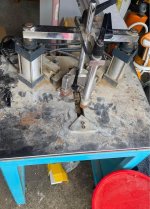jaguar36
Member
- Joined
- Jul 19, 2011
- Messages
- 281
I tend to buy glue by the gallon, but then I end up not using it for awhile either because it gets lost on the shelf or whatever. Titebond says it only has a shelf life of two years. I wanted to see if the strength actually degrades beyond that. I've also always heard that the strength of the glue doesn't matter as its always stronger than the wood. So I built a test rig based on ASTM D905 to test the strength. I made up a bunch of samples out of both oak and cherry as I thought they had the best chance of being stronger than the glue. I tested 5 different types of Titebond glues, a 5 Year old bottle of Titebond Original, a new bottle, as well as Titebond 2, 3 and Hide glue. Here is the results:
Cherry:
[attachimg=1]
Oak:
[attachimg=2]
Looking at the results for Cherry it doesn't appear to matter that the glue was old. However on the oak the old glue does appear to be about 10% weaker. It is possible that is correct and it just doesn't show up with the cherry as the cherry wood isn't strong enough to show it. 10% could also just be a statistical anomaly, with only 7 samples a 10% variation is easily within the error of the testing.
I was also glad to see that indeed the strength of the glue matter between the 3 'normal' types. (Hide glue obviously being weaker)
Why do folks use Titebond 2? It seems like its the worst of the three? Very short open time, not as water proof as Titebond 3, more expensive than Original. And yet it is apparently the best selling Titebond.
If you want to see just how I did the testing, check out the video here:
Cherry:
[attachimg=1]
Oak:
[attachimg=2]
Looking at the results for Cherry it doesn't appear to matter that the glue was old. However on the oak the old glue does appear to be about 10% weaker. It is possible that is correct and it just doesn't show up with the cherry as the cherry wood isn't strong enough to show it. 10% could also just be a statistical anomaly, with only 7 samples a 10% variation is easily within the error of the testing.
I was also glad to see that indeed the strength of the glue matter between the 3 'normal' types. (Hide glue obviously being weaker)
Why do folks use Titebond 2? It seems like its the worst of the three? Very short open time, not as water proof as Titebond 3, more expensive than Original. And yet it is apparently the best selling Titebond.
If you want to see just how I did the testing, check out the video here:




